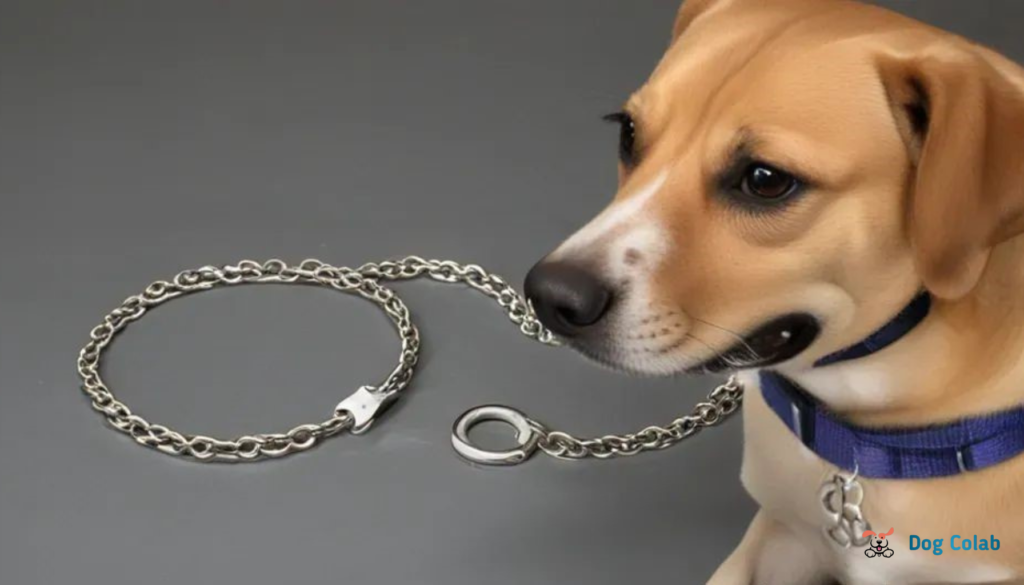Learn the proper technique of using a choke collar to train your dog effectively with expert guidance from Dogcolab.net. Start training your furry friend today!
Understanding Choke Collars
Choke collars, also known as chain training collars or correction collars, are specifically designed for training purposes and not for everyday use. These collars are meant to provide a gentle correction rather than serve as a punishment tool.
Step-by-Step Guide to Using a Choke Collar
Preparing the Choke Collar
- First Setup: First, make sure the choke collar fits tightly around the dog’s neck, leaving two fingers between the collar and the dog.
- Create the ‘P’ Shape: Till the collar takes the shape of a “P,” feed the chain through one of the end rings. This is essential for the collar to be positioned correctly.
- Positioning on the Dog: While the dog is seated, place the collar over its head. For simple release following correction, make sure the “live ring” is on top.

Correct Placement and Adjustment
- High on the Neck: Behind the dog’s ears, place the choke chain high on the neck. For training to be safe and with good communication, this place is necessary.
- Changing the Fit: Make sure the collar fits snugly around the dog’s neck without becoming uncomfortable. This keeps the collar from getting too tight and hurting or uncomfortable.
- Select the Side You’ll Walk: Choose the side your dog will walk on when walking—your left or right. The ‘live ring’ on the collar should face forward when adjusted for a simple and rapid release.
During the Training Session
- Applying Corrections: Make use of the release and correction technique. When the dog pulls, give them a fast pop and let go right away to encourage them to change their behavior. This technique spares the dog from ongoing tugging and stress.
- Keeping an eye on the collar: During training, make sure the chain pulls through the ring straight and does not form a ‘U’ shape, which could complicate release and increase risk. Check the collar frequently.
- Following Training: After a training session, remove the choke collar to avoid any unintentional injuries or pain when not in active training.
Key Components and Correct Usage
- The choke collar has two rings: the live ring allows the chain to tighten and release using gravity when positioned on top, making the experience safer for the dog. The dead ring functions as a loop through which the chain is passed.
- Correct Positioning: Always place the live ring on top to keep the chain from constantly tightening, which can be dangerous.
- Consultation with professionals: Before employing a choke collar, speak with a professional trainer or behaviorist to avoid misuse and serious injury.
Training Techniques Using a Choke Collar

Key Principles in Choke Collar Training
Understanding Pressure and Release:
The choke collar is designed to deliver fast pressure on the dog’s jugular, signaling the brain to change behavior. This approach should include a quick tug and immediate release, sometimes known as the ‘pop and release’ method, which is critical for effective training.
Utilizing Sound as a Behavioral Cue:
Interestingly, some dogs may adjust their behavior simply by hearing the sound of the chain moving through the ring. This auditory cue can sometimes suffice, reducing the need for physical correction.
Avoiding Continuous Pressure:
The choke collar should never be tightened for an extended period of time. Constant pressure can be damaging and counterproductive, negating the goal of training and sometimes causing discomfort or injury to the dog.
Positive Reinforcement and Alternatives
Though choke collars are helpful, using them along with positive reinforcement makes training easy for both animals and humans. This means is to encourage the dog for its good behavior rather than punishing the bad, building a better link between the dog and its owner. There is also the prong collar which receive firm control without the need of harsh corrections, and is known to be a stress-free control tool when compared to the head halter.
Openness to Training Adaptability
Training strategies should be adaptable. Being open to new ideas and willing to change approaches based on the dog’s response is critical. Remember, the goal is to achieve effective communication and behavior adjustment without causing distress or harm.
Choosing the Right Choke Collar

Assessing Collar Size and Quality
- Correct Sizing: The right approach is sizing it perfectly. The collar’s fabric should be of the proper size so that it neither approximately around the dog’s neck but rather it should be slightly tight to give the dog a more formal look especially when viewing it from an outside. Firstly, estimation is done by measuring the widest point of the dog’s head (we take this at the front side of the ears) and add two to three inches to it. It should be enough for you to slip the collar over the head easily every time.
- Quality Inspection: When selecting a collars for your pet, ensure that you only go for top-notch preferably choke chain inspect it at least once a week for any indication of wear or tear. Before each use, make sure to give a few good pulls on the collar to make sure that everything orderly in place.
- Choosing the Right Type: The Herm Sprenger Labrador Training Collar is highly recommended for such strong durability and quality nature. This buckle type is different from the other type since it comes with unclickable latches which mean it’s just going to slide in and out, hence it’s easy to use and still secure.
Size Adaptation for Growing Dogs
- Adjusting for Growth: While determining the size the collar for a puppy should be chosen which should be monitored as they grow. Though, the collar that best fits in the beginning, may shrink up tighter as a puppy grows. Frequent reassessments are essential in this case to be able to keep comfort and safety at the highest level.
Fitting the Collar
- Testing Fit and Comfort: Once you’ve chosen the right size, try it on your dog. The collar should be entirely relaxed, with around 6 inches of slack chain to prevent it from tightening too much. This slack enables for required corrections during training without causing discomfort or injury.
By following these principles, you can find a choke collar that is both helpful for training and safe for your dog.
Safety Tips and Common Mistakes to Avoid
Consultation and Quality Checks
- Professional Guidance: Always consult with a professional trainer or behaviorist before using any type of collar or training tool on your dog to ensure safe and effective usage.
- Quality Assurance: Regularly inspect the choke collar for any signs of wear and tear. Ensure that the collar is in good working condition before each use to prevent any potential failure during training sessions.
Proper Use and Handling
- Avoid Unsupervised Use: Never leave a choke collar on a dog when unattended. This precaution prevents risks such as strangulation or other injuries.
- Interaction Caution: When your dog is interacting https://dogcolab.net/best-dog-collar-to-prevent-matting/https://dogcolab.net/best-dog-collar-to-prevent-matting/with other dogs, remove the choke collar to avoid accidents, such as entanglement or choking, which can occur if another dog catches hold of the collar.
- Walking Guidance: Never walk your dog on a choke collar if they are inclined to pull. This can lead to self-inflicted choking and should be strictly avoided.
FAQ’s
What is the correct method for using a choke collar?
The proper use of a choke collar is crucial for ensuring it is safe and effective. It should sit high on your dog’s neck, just behind their ears. The collar should be fitted so that it tightens with a pull but immediately loosens when the tension is released.
How should a choke collar be put on a dog?
To put on a choke collar, ensure the chain forms a ‘P’ shape when you hold it up before placing it over your dog’s head. This orientation ensures that the collar releases properly after tightening.
What steps are involved in operating a pinch collar?
To open and close a pinch collar, first, ensure that the links are correctly aligned. Then, detach or attach links to fit or remove the collar, ensuring that it is neither too tight nor too loose around your dog’s neck.
Are choke collars recommended for training dogs?
Choke collars are generally not recommended for dog training. They can be easily misused, causing harm to the dog. With many humane and effective alternatives available on the market, using choke collars is unnecessary and should be avoided.

